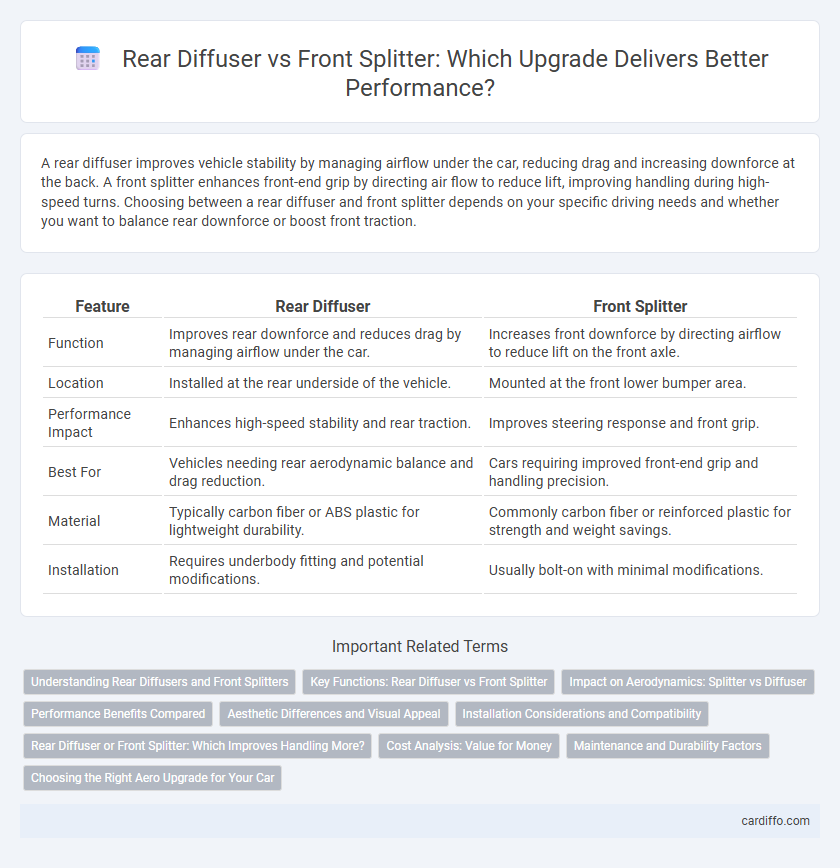A rear diffuser improves vehicle stability by managing airflow under the car, reducing drag and increasing downforce at the back. A front splitter enhances front-end grip by directing air flow to reduce lift, improving handling during high-speed turns. Choosing between a rear diffuser and front splitter depends on your specific driving needs and whether you want to balance rear downforce or boost front traction.
Table of Comparison
| Feature | Rear Diffuser | Front Splitter |
|---|---|---|
| Function | Improves rear downforce and reduces drag by managing airflow under the car. | Increases front downforce by directing airflow to reduce lift on the front axle. |
| Location | Installed at the rear underside of the vehicle. | Mounted at the front lower bumper area. |
| Performance Impact | Enhances high-speed stability and rear traction. | Improves steering response and front grip. |
| Best For | Vehicles needing rear aerodynamic balance and drag reduction. | Cars requiring improved front-end grip and handling precision. |
| Material | Typically carbon fiber or ABS plastic for lightweight durability. | Commonly carbon fiber or reinforced plastic for strength and weight savings. |
| Installation | Requires underbody fitting and potential modifications. | Usually bolt-on with minimal modifications. |
Understanding Rear Diffusers and Front Splitters
Rear diffusers enhance vehicle aerodynamics by managing airflow underneath the car, reducing drag and increasing downforce for improved stability at high speeds. Front splitters direct air flow away from the front tires, increasing front-end downforce and enhancing steering response. Both components work synergistically to optimize overall aerodynamic performance and handling dynamics.
Key Functions: Rear Diffuser vs Front Splitter
Rear diffusers enhance vehicle stability by managing airflow underneath the car, reducing drag and increasing downforce at the rear for improved traction. Front splitters improve front-end grip by redirecting air pressure upward, generating additional downforce to prevent lift on the front wheels. Both components optimize aerodynamic efficiency but target different areas to balance overall vehicle handling and performance.
Impact on Aerodynamics: Splitter vs Diffuser
A front splitter enhances aerodynamics by increasing front-end downforce, which improves grip and stability at high speeds through effective air pressure management under the vehicle. A rear diffuser optimizes airflow exiting from under the car, reducing turbulence and drag while increasing rear downforce, enhancing overall balance and high-speed cornering. Together, these components work to create a more stable and aerodynamically efficient vehicle by managing airflow front-to-rear.
Performance Benefits Compared
A rear diffuser enhances vehicle stability by managing airflow underneath the car, reducing lift and increasing downforce for improved traction during high-speed cornering. In contrast, a front splitter generates downforce at the front axle, increasing grip and steering response by directing airflow upward and reducing front-end lift. Combining both upgrades optimizes aerodynamic balance, resulting in superior overall performance and handling precision.
Aesthetic Differences and Visual Appeal
The rear diffuser enhances a car's visual appeal by emphasizing aggressive, sporty rear-end design and creating a sense of lowered stance through its sculpted fins and air channels. The front splitter contributes to the vehicle's aesthetics by providing a sharp, aerodynamic look that accentuates the front bumper's width and creates a ground-hugging appearance. Both components serve as signature styling elements but differ in their placement and the way they visually balance the car's overall design.
Installation Considerations and Compatibility
When upgrading automotive aerodynamics, installation considerations play a key role in choosing between a rear diffuser and a front splitter. Rear diffusers generally require modifications to the underbody and may need space clearance, affecting compatibility with vehicles that have low ground clearance or complex exhaust layouts. Front splitters demand precise mounting on the front bumper and must align with the vehicle's specific aerodynamic design to ensure proper fitment and optimal performance.
Rear Diffuser or Front Splitter: Which Improves Handling More?
Rear diffusers enhance handling by increasing downforce and improving aerodynamic stability at high speeds, reducing drag and lift simultaneously. Front splitters effectively manage airflow to generate front-end downforce, improving steering response and grip during cornering. Optimizing handling often depends on vehicle setup, but a rear diffuser generally provides more significant overall stability benefits compared to a front splitter.
Cost Analysis: Value for Money
A rear diffuser typically costs between $150 and $500, offering aerodynamic benefits that improve stability and fuel efficiency, making it a cost-effective upgrade for handling performance. Front splitters range from $200 to $700, providing enhanced downforce and aggressive styling but often requiring additional modifications for optimal fitment, increasing overall expenses. Considering value for money, rear diffusers deliver significant performance gains at a lower price point, while front splitters offer more noticeable visual impact that justifies the higher investment for enthusiasts prioritizing aesthetics.
Maintenance and Durability Factors
Rear diffusers typically require less frequent maintenance compared to front splitters due to their position away from road debris and impact zones, enhancing durability over time. Front splitters are more susceptible to damage from curbs, speed bumps, and road debris, necessitating regular inspections and potential repairs, which affects long-term upkeep costs. Material quality such as carbon fiber or reinforced plastic significantly influences the lifespan and resilience of both components under varying driving conditions.
Choosing the Right Aero Upgrade for Your Car
Rear diffusers enhance high-speed stability by managing turbulent airflow under the car, reducing drag and increasing downforce on the rear axle. Front splitters improve front-end grip and steering response by generating downforce at the front wheels, crucial for cornering performance. Selecting the right aero upgrade depends on your driving style, with rear diffusers benefiting high-speed stability and front splitters optimizing cornering and braking control.
Rear Diffuser vs Front Splitter Infographic

 cardiffo.com
cardiffo.com